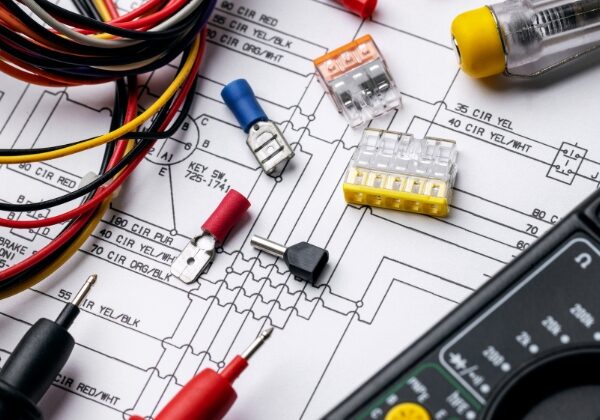
The manufacturing of electrical panels has undergone significant changes, evolving from traditional methods to modern techniques. Here’s a look at how electrical panel manufacturing has progressed.
Energy automation solutions are essential for modernizing energy management and improving operational efficiency. Schneider Electric is at the forefront of providing these solutions, offering products and systems that enhance automation in energy systems. This blog explores energy automation solutions and how Schneider Electric’s products can benefit your operations.
What Are Energy Automation Solutions?
Energy automation solutions involve the use of technology to control and optimize energy systems automatically. This includes systems for monitoring energy usage, controlling equipment, and integrating with other automation technologies.
Schneider Electric’s Energy Automation Products
- Programmable Logic Controllers (PLCs): Schneider Electric’s PLCs are crucial for automating industrial processes and controlling various functions within energy systems.
- Variable Frequency Drives (VFDs): VFDs from Schneider Electric help regulate the speed and torque of motors, improving energy efficiency and performance.
- Energy Management Systems: These systems provide real-time data and analytics to optimize energy use and enhance overall system efficiency.
Benefits of Schneider Electric’s Energy Automation Solutions
- Increased Efficiency: Automation reduces manual intervention, streamlining operations and improving overall efficiency.
- Cost Savings: By optimizing energy use and reducing waste, Schneider Electric’s solutions help lower operational costs.
- Enhanced Control: Advanced automation provides better control over energy systems, allowing for more precise management and improved performance.
Traditional Manufacturing Techniques
In the past, electrical panels were often manufactured using traditional methods that involved manual assembly and limited technology. These panels were functional but lacked the advanced features and efficiency of modern panels.
Advancements in Technology
With technological advancements, the manufacturing process has become more sophisticated. Modern techniques include the use of automated machinery, advanced materials, and computer-aided design (CAD) systems. PIMA leverages these advancements to produce high-quality, efficient electrical panels.
Integration of Smart Technologies
One of the most significant changes in electrical panel manufacturing is the integration of smart technologies. Modern panels now include features such as remote monitoring, automated controls, and real-time data analysis. PIMA’s panels incorporate these technologies, enhancing functionality and efficiency.
Enhanced Safety and Compliance
Modern manufacturing techniques emphasize safety and compliance with regulatory standards. Panels are designed with advanced safety features and undergo rigorous testing to meet industry standards. PIMA’s commitment to safety and compliance ensures that their panels meet the highest standards.
Customization and Flexibility
Today’s manufacturing techniques offer greater customization and flexibility. Panels can be tailored to meet specific requirements and adapt to changing needs. PIMA’s custom control panels exemplify this flexibility, providing solutions that are tailored to unique operational demands.
Sustainability and Efficiency
Modern manufacturing focuses on sustainability and energy efficiency. Panels are designed to minimize environmental impact and reduce energy consumption. PIMA’s commitment to sustainability ensures that their panels are both eco-friendly and efficient.
Integrated energy solutions are crucial for managing energy consumption and optimizing efficiency. Schneider Electric excels in providing these solutions, offering products and systems that integrate seamlessly to enhance energy management. This blog explains integrated energy solutions and how Schneider Electric leads in this field.
What Are Integrated Energy Solutions?
Integrated energy solutions combine various technologies and systems to manage and optimize energy use across multiple platforms. These solutions typically include energy management systems, smart grid technologies, and energy storage systems.
Schneider Electric’s Integrated Solutions
- Energy Management Systems: Schneider Electric’s systems integrate with existing infrastructure to provide real-time monitoring and control of energy usage, helping organizations reduce costs and improve efficiency.
- Smart Grid Technologies: Schneider Electric’s smart grid solutions enhance grid reliability and efficiency, enabling better management of energy distribution and consumption.
- Energy Storage Solutions: Schneider Electric offers advanced energy storage systems that support renewable energy integration and provide backup power solutions.
Benefits of Schneider Electric’s Integrated Solutions
- Efficiency: Integrated solutions streamline energy management, reducing waste and improving overall system performance.
- Flexibility: Schneider Electric’s solutions are designed to adapt to different environments and requirements, offering customizable options to meet specific needs.
- Sustainability: By optimizing energy use and incorporating renewable energy sources, Schneider Electric’s solutions contribute to a more sustainable future.
The evolution of electrical panel manufacturing reflects advancements in technology and design. PIMA’s adoption of modern techniques ensures that their panels are at the forefront of innovation, providing enhanced performance and reliability.











